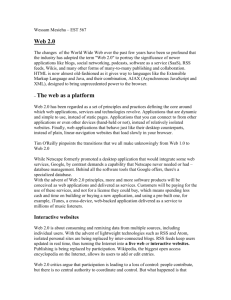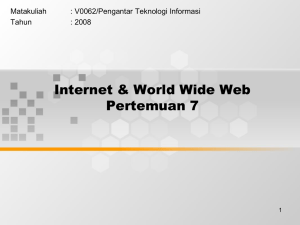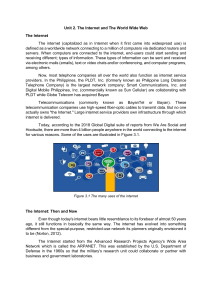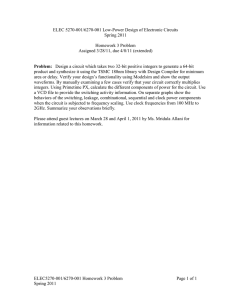Understanding the Internet: History, Function, and Data Transfer
advertisement
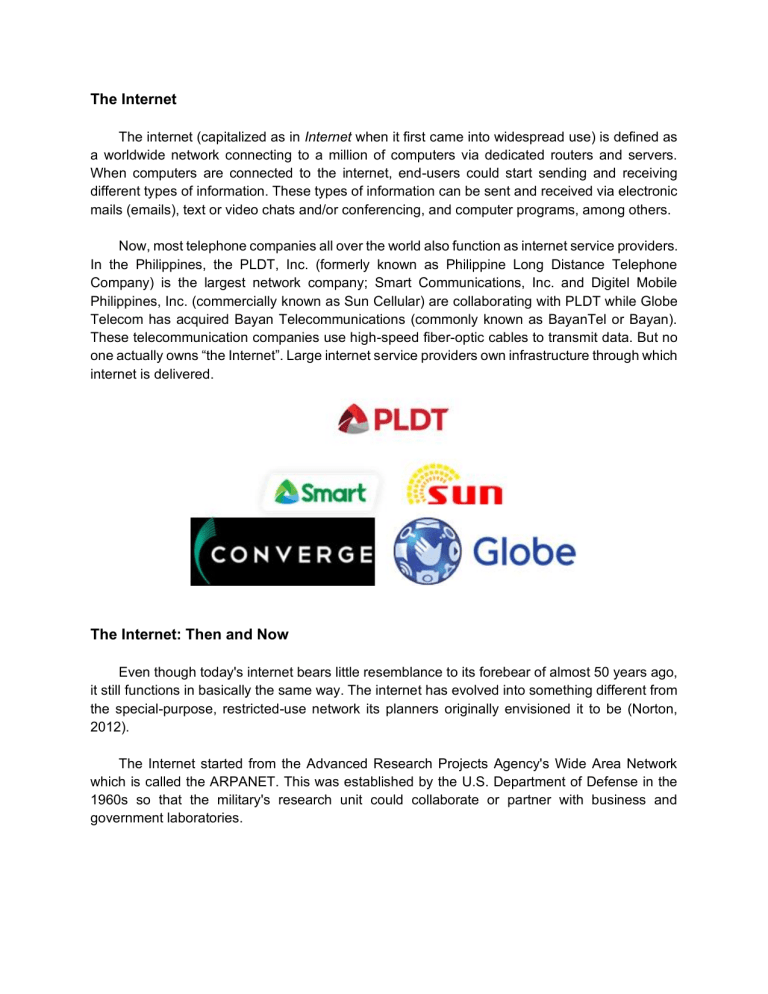
The Internet The internet (capitalized as in Internet when it first came into widespread use) is defined as a worldwide network connecting to a million of computers via dedicated routers and servers. When computers are connected to the internet, end-users could start sending and receiving different types of information. These types of information can be sent and received via electronic mails (emails), text or video chats and/or conferencing, and computer programs, among others. Now, most telephone companies all over the world also function as internet service providers. In the Philippines, the PLDT, Inc. (formerly known as Philippine Long Distance Telephone Company) is the largest network company; Smart Communications, Inc. and Digitel Mobile Philippines, Inc. (commercially known as Sun Cellular) are collaborating with PLDT while Globe Telecom has acquired Bayan Telecommunications (commonly known as BayanTel or Bayan). These telecommunication companies use high-speed fiber-optic cables to transmit data. But no one actually owns “the Internet”. Large internet service providers own infrastructure through which internet is delivered. The Internet: Then and Now Even though today's internet bears little resemblance to its forebear of almost 50 years ago, it still functions in basically the same way. The internet has evolved into something different from the special-purpose, restricted-use network its planners originally envisioned it to be (Norton, 2012). The Internet started from the Advanced Research Projects Agency's Wide Area Network which is called the ARPANET. This was established by the U.S. Department of Defense in the 1960s so that the military's research unit could collaborate or partner with business and government laboratories. Before it became known as the Internet, ARPA's network served universities, defense contractors, and a few government agencies. Source: https://www.timetoast.com/timelines/computer-history-timeline--67 Afterwards, other universities and U.S. institutions were connected to ARPANET that resulted in the growth of ARPANET different from everyone's expectations. ARPANET then attained the name of "Internet." The advancement of hypertext-based technology known as World Wide Web, WWW, or just simply as the Web has provided the channels for displaying text, graphics, animations, etc. Its other features of enabling easy search and offering navigation tools prompted the internet's unpredictable worldwide growth. The Internet2 Environment: Future Empowerment Internet2 is a not-for-profit networking consortium founded in 1996 by 34 university research institutions in the U.S. It provides a collaborative environment where U.S. research and education organizations work together and develop advanced technologies and innovative solutions such as telemedicine, digital libraries and virtual laboratories, and virtual laboratories to assist education, research, and community development. Internet2 manages the Internet2 Network, a next-generation optical and internet protocol network that is capable of delivering enhanced network services and is better, faster, and more efficient than the typical internet or broadband connections. Internet2 maintains a secure network testing and research environment. It began operating the Internet2 DCN (dynamic circuit network), an advanced technology that allows user-based allocation of data circuits over the fiberoptic network. As of May 2016, this community comprises 317 U.S. higher education institutions, 81 corporations, 64 affiliates and affiliate members, 43 regional and state education networks, and more than 65 national research and education networking partners representing over 100 countries. The Philippines, via the Philippine Research, Education and Government Information Network (PREGINET), is among the international peers reachable via Trans-Eurasia Information Network (TEIN), one of the Internet2's peering relationships. Just in August 2017, a national training course on nuclear neurology was held in which nationwide webcast among hospitals was made possible through the high-speed connectivity provided by PREGINET and the video conference server hosted locally at the Department of Science and Technology-Advanced Science and Technology Institute (DOST-ASTI). By supporting telemedicine or telehealth in the country, this information infrastructure, therefore, enables Philippine hospitals to keep abreast of new medical diagnostics and world-class treatment options without having to travel abroad. Internet Today: Still Growing Today, the internet connects thousands of networks and billions of users around the world. The number of internet users as of January 2018 is 4.021 billion which means that more than half of the world's population is now online as revealed by, We Are Social and Hootsuite in their 2018 Global Digital suite of reports. Despite this huge number, the internet has no central ownership. It means that no single person or group controls the network. Although there are several organizations (such as The Internet Society and the World Wide Web Consortium) that propose standards for internet-related technologies and guidelines for its appropriate use, these organizations almost universally support the internet's openness and lack of centralized control. As a result, the internet is open to anyone who can access it. If one can use a computer and if the computer is connected to the internet, he or she is free not only to use the resources posted by others, but also to create resources of his or her own; that is, the internet user can publish documents on the World Wide Web, exchange email messages with other users, and perform many other tasks. Jobs the Internet Can Do Internet users may wonder about the jobs that the internet can do. However, there is only one simple job that the internet does, and it is to move, transfer, or assign computerized information from one place to another. This information can be in the form of text documents, images, audio, video, and software programs, among others. All this information is known as data. The internet can handle different kinds of information and assist people to perform various jobs from the simple tasks of handling email, searching on websites, and sending chat messages to the more sophisticated function of creating websites and programming possible through various software programs. How Data Travels the Internet Data and information are transferred around the world through wired or wireless transmission media. In the Philippines, the transmission media that make up the internet backbone allow information or data exchanges between networks at several locations across the country, such as La Union in the northern part, and Batangas, Cavite, and Davao down south. The high-speed equipment in these sites functions similarly to a highway interchange. Data is transferred from one network to another until it reaches its final destination Much of the internet runs on the ordinary public telephone network. However, there is a big difference between how a telephone call works and how the internet carries data. For example, friend A gives friend B a telephone call; the telephone then opens a direct connection (also known as the circuit) between friend A's home and friend B's home. In this scenario, a direct line can be pictured out, running along miles of cable, from friend A's telephone to friend B's telephone. As long as the two friends are over the telephone, that connection or circuit stays open between the two telephones. This method of linking the telephones together is called circuit switching. Circuit switching is one of the most common schemes utilized to build a communications network, such as the case of ordinary telephone calls. Circuit switching, however, is inefficient because if you stay connected with your friend or relative over the phone all the time, the circuit is still connected, and is, therefore, blocking other people from using it. A traditional dial-up connection to the net, in which a computer dials a telephone number to reach the internet service provider, uses circuit switching. This appears inefficient because browsing the internet and using the telephone at the same time are not possible. As time goes by, technologies are improved and developed as well. Most data that moves over the internet in an entirely different way is called packet switching. This is a mode of transmission in which the message is broken into smaller parts (called packets) which are sent independently, and then reassembled at the ultimate destination. Suppose an email from the Philippines is sent to someone in South Korea, Singapore, Thailand, China, Italy, the U.S. and other countries. Instead of having a knotty circuit between the home in the Philippines and those in the mentioned countries, and sending the email in one go, the email is "broken" into tiny pieces (happens at the back of the system). Theoretically, these packets are assigned their ultimate destination. They travel via different routes, and when they reach their definitive destination, these packets will then reassemble to make the email message one and complete. Compared to circuit switching, packet switching, therefore, is much more efficient. A permanent connection is not necessary between the two places communicating, which avoids blocking the entire chunk of the network each time a message is sent. What Computers Do on the Internet Computers do different jobs on the internet. Some computers work like electronic filing cabinets that store information and send it when clients request so. These are called servers. A server is a computer that is designed to process any requests for data and delivers data to other client computers over a local network or the internet. A client is a computer or device that gets information from a server. Any computer running with special software can function as a server, and servers have different roles to play. A computer that holds the user accounts, computer accounts, organizational units, and application services is called the Active Directory Domain Services (AD DS). Another machine that helps the Dynamic Host Configuration Protocol (DHCP) server is a server that configures IPv4 and IPv6 addresses specifically in giving names to each IP address up to its root recognition which is called domain name system (DNS) server. Another machine that holds and manages documents is known as the file server while the other one that holds users' mail services and Web services is referred to as Web Server II. A device that connects printers to client computers through the internet is called a print server. It accepts print jobs from the computers, queues these jobs, and sends them to the appropriate printers. Besides clients and servers, the internet is made up of a hardware device designed to receive, analyze, and send incoming packets to another network. This is called a router. Having several computer devices both at home and in school, you probably have a router that connects all of your devices to the internet. The router can be compared to a simple mailbox placed at the corner of a street and which represents your single point of entry to the worldwide network. The World Wide Web The World Wide Web (www) is referred to as the collection of public websites that are connected to the internet worldwide, together with the client computers which include personal computers, laptops, iPads, and cellular phones that access its content. Web Technologies The WWW is considered to be one of the applications in the internet and computer networks. This is based on three fundamental technologies that are said to be part of the WWW development: ● Hypertext markup language (HTML) – is a standard markup language used for creating web pages. HTML is classified as the set of markup symbols or codes appended in a file intended for presentation on a World Wide Web browser page. ● Hypertext transfer protocol (HTTP) - is classified as the set of standards allowing users of the World Wide Web to interchange information seen on web pages. Port 80 is the standard port for HTTP connections. ● Web servers and web browsers - is a software application for recovering, presenting, and navigating information resources on the World Wide Web. There are different browser applications that are currently used in the WWW such as Microsoft Edge, Google Chrome, Internet Explorer, Mozilla Firefox, Safari, and more. The World Wide Web Today Last March 12, 2017, WWW turned 28 years, a milestone that recalls the invention of the WWW which has changed humanity forever, and developed a new virtual world within a generation. There are known websites that enhanced their features in terms of design and development style to adapt to the speedily growing techniques of the users' way of retrieving the Web from large screen computers to small-screen mobile phones. It is observed and shown that the way the Web works is reasonably simple having its four basic stages: connection, request, response, and close. The first stage is where many users access the browsers such as Internet Explorer, Google Chrome, and Mozilla Firefox (some of the most used browsers) to connect to the Web server. Browsers work by using a unique protocol known as the HTTP which demands a particular programmed text from the web server. The text is actually written in HTML format that informs the browser on how it will display the text on the user's screen. Different technical terms are used in explaining how the Web works. One of the most important terms to know is the uniform resource locators (URLS) which is sorted as the internet address. A URL contains four parts, namely the protocol identifier which indicates the protocol to use, the domain name which specifies the IP address where the resource is located, the path, and the file name (Mitchell, 2017). Searching for Information on the Web A website is maintained by its owner, called a web administrator. The owner can modify the website content as well as add new information in it. However, no single organization controls additions, deletions, and changes to all websites. This means there is no single repository for all the websites found on the internet. Several companies, however, maintain organized directories of websites to help people find information about specific topics (Shelly, Cashma, & Vermaat, 2011). There are two mainly managed search tools that people use in locating information on the web: subject directories and search engines. Subject directories are developed and maintained by human editors and not by electronic spiders or robots that are used to fetch web pages automatically. A search engine, on the other hand, uses small programs called spiders or bots (like Googlebot, Yahoo Slurp, and MSNbot) that polish the internet, follow links, and return information to the search engine's indicator. If you enter a phrase with spaces between the words in the search text, most search engines return links to pages that include all of the words. There are several techniques that can be used to improve web searches such as: ● Using specific words and placing the most important terms first in the search text or phrase ● Using quotation marks to create exact phrases-this helps the search engine find what it is looking for by using the exact sequence of words ● Listing all possible spellings, for example, organization and organisation In addition to searching for web pages, many search engines allow searching for images, news articles, and various reports in different formats. One of the most popular search engines now is Google. Below is an overview of some of the most useful Google search tricks released in 2016, from basic tips to new features. 1. Use quotes to search for an exact phrase - By typing in double-quotes (") at the start and end for a certain word or phrase, Google will provide the exact word or phrasing you need. 2. Use an asterisk within quotes to specify unknown or variable words - the asterisk symbol () will provide possibilities. It is helpful, for example, if you are trying to determine a song from its lyrics, but you forgot some of the words or if you are trying to complete a sentence, but could not remember what it was. 3. Use the minus sign to eliminate results containing certain words - While the asterisk gives you possibilities, the minus sign (-) eliminates results of certain words. Just type the minus sign prior to the word you do not want to include in the search. 4. Search websites for keywords - You can specify certain content, format, or files you want Google search to provide. For instance, if you want to specifically search for PDF files regarding a certain topic, simply type the keyword PDF followed by a colon symbol (:) and the topic you are searching for. 5. Compare using “vs" - By using the "vs" or "versus" between two words you want to compare, Google will provide an in-depth analysis of the two words, such as pointing out similarities and differences. 6. Use “DEFINE:" to search for the meaning of words- slang included - The "DEFINE:" keyword provides a dictionary definition of a word. Also, you will be able to see etymology and a graph of its use over time. 7. Search images using images - Using your mobile device's camera, you can search for images online by going to Google Images, activating your camera phone and taking a picture of the image you are searching for. Google will provide you with similar images on the web. Additional Search Functions Link >> https://www.lifehack.org/articles/technology/20-tips-use-google-search-efficiently.html REFERENCES Internet. (n.d.). BusinessDictionary.com. www.businessdictionary.com/definition/internet.html Retrieved from http:// Internet2. Internet2.edu. Retrieved from https://www.Internet2.edu/about-us/ Johnson, A. (2016, February 21). WAN technologies. Retrieved http://www.pearsonitcertification.com/articles/article.aspx?p=2481850&seqNum=3 from Kemp, S. (2018, January 30). Digital in 2018: World's internet users pass the 4 billion mark. Retrieved from https://wearesocial.com/blog/2018/01/global-digital-report-2018 Mitchell, B. (2017, May 5). What is a server in computer networking? Retrieved from https://www.lifewire.com/server-in-computer-networking-817380 Mitchell, B. (2017, May 19). WWW- World https://www.lifewire.com/history-of-world-wide-web-816583 Wide Web. Retrieved from Norton, P. (2012). Introduction to networks (6th ed.). Tata McGraw-Hill Education Private Limited. Shelly, G. B., Cashman, T. J., & Vermaat, M. E. (2011). Discovering computers fundamentals, 1. Boston, MA: Thomson Course Technology. (Original work published on February 2007)
